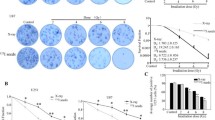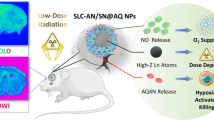Abstract
Radioactive 125I seeds-based radiotherapy has achieved great success in treatment of human cancers. However, radioresistance and severe side effects badly limited its clinic application. Recently, chemoradiotherapy as a superior strategy has been rapidly developed and widely used in clinic. However, the underlying mechanism remains elusive. Herein, in the present study, a combined chemoradiation model of 125I seeds and salinomycin (SAL) in vitro and in vivo was designed, and the enhanced anticancer efficiency and mechanism were also evaluated in human glioma. The results showed that combined treatment of 125I seeds and SAL induced enhanced growth inhibition against human glioma cells through induction of cell apoptosis. Further investigation revealed that combined treatment of 125I seeds and SAL triggered enhanced DNA damage through inducing reactive oxide species (ROS) generation. Additionally, enhanced dysfunction of MAPKs and AKT pathways both contributed to combined treatment-induced growth inhibition against human glioma cells. Importantly, the U251 human glioma xenograft growth was effectively inhibited by combined treatment of 125I seeds and SAL by induction of cell apoptosis with involvement of inhibiting cell proliferation and angiogenesis. Taken together, our results indicated that combined treatment of 125I seeds and SAL achieved enhanced growth inhibition and apoptosis in human glioma in vitro and in vivo through triggering ROS-mediated DNA damage and regulation of MAPKs and AKT pathways, which validated that the combined strategy of using 125I seeds and SAL could be a highly efficient way to achieve enhanced glioma chemo-radiotherapy.





Similar content being viewed by others
References
Huse JT, Holland EC (2010) Targeting brain cancer: advances in the molecular pathology of malignant glioma and medulloblastoma. Nat Rev Cancer 10:319–331
Parsons DW, Jones S, Zhang X, Lin JC, Leary RJ, Angenendt P, Mankoo P, Carter H, Siu IM, Gallia GL, Olivi A (2008) An integrated genomic analysis of human glioblastoma multiforme. Science 321:1807–1812
Dewan MC, White-Dzuro GA, Brinson PR, Thompson RC, Chambless LB (2016) Perioperative seizure in patients with glioma is associated with longer hospitalization, higher readmission, and decreased overall survival. J Neurosurg 125:1033–1041
Ho AL, Koch MJ, Tanaka S, Eichler AF, Batchelor TT, Tanboon J, Louis DN, Cahill DP, Chi AS, Curry WT Jr (2016) Impact of histopathological transformation and overall survival in patients with progressive anaplastic glioma. J Clin Neurosci 31:99–105
Schaff LR, Lassman AB (2015) Indications for treatment: is observation or chemotherapy alone a reasonable approach in the management of low-grade gliomas? Semin Radiat Oncol 25:203–209
Tian Y, Xie Q, He J, Luo X, Zhou T, Liu Y, Huang Z, Tian Y, Sun D, Yao K (2015) Radioactive (125)I seeds inhibit cell growth and epithelial-mesenchymal transition in human glioblastoma multiforme via a ROS-mediated signaling pathway. BMC Cancer 15:1. https://doi.org/10.1186/1471-2407-15-1
Tian Y, Xie Q, Tian Y, Liu Y, Huang Z, Fan C, Hou B, Sun D, Yao K, Chen T (2013) Radioactive (1)(2)(5)I seed inhibits the cell growth, migration, and invasion of nasopharyngeal carcinoma by triggering DNA damage and inactivating VEGF-A/ERK signaling. PLoS ONE 8:e74038
Hein AL, Ouellette MM, Yan Y (2014) Radiation-induced signaling pathways that promote cancer cell survival (review). Int J Oncol 45:1813–1819
Wilkinson-Ryan I, Binder PS, Pourabolghasem S, Al-Hammadi N, Fuh K, Hagemann A, Thaker P, Schwarz J, Grigsby P (2014) Concomitant chemotherapy and radiation for the treatment of advanced-stage endometrial cancer. Gynecol Oncol 134:24–28
Miyazaki Y, Shibuya M, Sugawara H, Kawaguchi O, Hirsoe C (1974) Salinomycin, a new polyether antibiotic. J Antibiot (Tokyo) 27:814–821
Dewangan J, Srivastava S, Rath SK (2017) Salinomycin: a new paradigm in cancer therapy. Tumour Biol 39:1010428317695035
Gupta PB, Onder TT, Jiang G, Tao K, Kuperwasser C, Weinberg RA, Lander ES (2009) Identification of selective inhibitors of cancer stem cells by high-throughput screening. Cell 138:645–659
Zhang G, Wang W, Yao C, Ren J, Zhang S, Han M (2017) Salinomycin overcomes radioresistance in nasopharyngeal carcinoma cells by inhibiting Nrf2 level and promoting ROS generation. Biomed Pharmacother 91:147–154
Zhao SJ, Wang XJ, Wu QJ, Liu C, Li DW, Fu XT, Zhang HF, Shao LR, Sun JY, Sun BL, Zhai J, Fan CD (2017) Induction of G1 cell cycle arrest in human glioma cells by salinomycin through Triggering ROS-mediated DNA damage in vitro and in vivo. Neurochem Res 42:997–1005
Managò A, Leanza L, Carraretto L, Sassi N, Grancara S, Quintana-Cabrera R, Trimarco V, Toninello A, Scorrano L, Trentin L, Semenzato G, Gulbins E, Zoratti M, Szabò I (2015) Early effects of the antineoplastic agent salinomycin on mitochondrial function. Cell Death Dis 6:e1930
Kim KY, Park KI, Kim SH, Yu SN, Park SG, Kim YW, Seo YK, Ma JY, Ahn SC (2017) Inhibition of autophagy promotes salinomycin-induced apoptosis via reactive oxygen species-mediated PI3K/AKT/mTOR and ERK/p38 MAPK-dependent signaling in human prostate cancer cells. Int J Mol Sci 18:1088
Parajuli B 1st, Lee HG, Kwon SH, Cha SD, Shin SJ, Lee GH, Bae I, Cho CH (2013) Salinomycin inhibits Akt/NF-kappaB and induces apoptosis in cisplatin resistant ovarian cancer cells. Cancer Epidemiol 37:512–517
Lu D, Choi MY, Yu J, Castro JE, Kipps TJ, Carson DA (2011) Salinomycin inhibits Wnt signaling and selectively induces apoptosis in chronic lymphocytic leukemia cells. Proc Natl Acad Sci USA 108:13253–13257
Zhou S, Wang F, Zhang Y, Johnson MR, Qian S, Wu M, Wu E (2014) Salinomycin suppresses PDGFRbeta, MYC, and Notch signaling in human medulloblastoma. Austin J Pharmacol Ther 2:1020
Zhou Y, Liang C, Xue F, Chen W, Zhi X, Feng X, Bai X, Liang T (2015) Salinomycin decreases doxorubicin resistance in hepatocellular carcinoma cells by inhibiting the beta-catenin/TCF complex association via FOXO3a activation. Oncotarget 6:10350–10365
Koo KH 1st, Kim H, Bae YK, Kim K, Park BK, Lee CH, Kim YN (2013) Salinomycin induces cell death via inactivation of Stat3 and downregulation of Skp2. Cell Death Dis 4:e693
Kim JH, Chae M, Kim WK, Kim YJ, Kang HS, Kim HS, Yoon S (2011) Salinomycin sensitizes cancer cells to the effects of doxorubicin and etoposide treatment by increasing DNA damage and reducing p21 protein. Br J Pharmacol 162:773–784
Kim WK 1st, Kim JH, Yoon K, Kim S, Ro J, Kang HS, Yoon S (2012) Salinomycin, a p-glycoprotein inhibitor, sensitizes radiation-treated cancer cells by increasing DNA damage and inducing G2 arrest. Investig New Drugs 30:1311–1318
Fernandes DC, Wosniak J Jr, Pescatore LA, Bertoline MA, Liberman M, Laurindo FR, Santos CX (2007) Analysis of DHE-derived oxidation products by HPLC in the assessment of superoxide production and NADPH oxidase activity in vascular systems. Am J Physiol Cell Physiol 292:C413–C422
Pelicano H, Carney D, Huang P (2004) ROS stress in cancer cells and therapeutic implications. Drug Resist Updates 7:97–110
Apel K, Hirt H (2004) Reactive oxygen species: metabolism, oxidative stress, and signal transduction. Annu Rev Plant Biol 55:373–399
Lloyd DR, Phillips DH, Carmichael PL (1997) Generation of putative intrastrand cross-links and strand breaks in DNA by transition metal ion-mediated oxygen radical attack. Chem Res Toxicol 10:393–400
Leach JK, Van Tuyle G, Lin PS, Schmidt-Ullrich R, Mikkelsen RB (2001) Ionizing radiation-induced, mitochondria-dependent generation of reactive oxygen/nitrogen. Cancer Res 61:3894–3901
Morgan MA, Lawrence TS (2015) Molecular pathways: overcoming radiation resistance by targeting DNA damage response pathways. Clin Cancer Res 21:2898–2904
Dent P, Yacoub A, Fisher PB, Hagan MP, Grant S (2003) MAPK pathways in radiation responses. Oncogene 22:5885–5896
Valerie K, Yacoub A, Hagan MP (2007) Radiation-induced cell signaling: inside-out and outside-in. Mol Cancer Ther 6:789–801
Johnson GL, Lapadat R (2002) Mitogen-activated protein kinase pathways mediated by ERK, JNK, and p38 protein kinases. Science 298:1911–1912
Sahlberg SH, Gustafsson AS, Pendekanti PN, Glimelius B, Stenerlöw B (2014) The influence of AKT isoforms on radiation sensitivity and DNA repair in colon cancer cell lines. Tumour Biol 35:3525–3534
Toulany M, Lee KJ, Fattah KR, Lin YF, Fehrenbacher B, Schaller M, Chen BP, Chen DJ, Rodemann HP (2012) Akt promotes post-irradiation survival of human tumor cells through initiation, progression, and termination of DNA-PKcs-dependent DNA double-strand break repair. Mol Cancer Res 10:945–957
Xu Z, Yan Y, Xiao L, Dai S, Zeng S, Qian L, Wang L, Yang X, Xiao Y, Gong Z (2017) Radiosensitizing effect of diosmetin on radioresistant lung cancer cells via Akt signaling pathway. PLoS ONE 12:e0175977
Acknowledgements
This study was supported by the National Natural Science Foundation of China No. 81501106 to C.-D. Fan, and Program of Science and Technology of Shandong No. 2014GGH218005 to C.-L. Li. and Natural Science Foundation of Shandong No. ZR2015HL050 to D.-W. Li.
Author information
Authors and Affiliations
Corresponding authors
Ethics declarations
Conflict of interest
The authors declare that they have no competing interest.
Electronic supplementary material
Below is the link to the electronic supplementary material.
Rights and permissions
About this article
Cite this article
Liu, C., Wang, L., Qiu, H. et al. Combined Strategy of Radioactive 125I Seeds and Salinomycin for Enhanced Glioma Chemo-radiotherapy: Evidences for ROS-Mediated Apoptosis and Signaling Crosstalk. Neurochem Res 43, 1317–1327 (2018). https://doi.org/10.1007/s11064-018-2547-2
Received:
Revised:
Accepted:
Published:
Issue Date:
DOI: https://doi.org/10.1007/s11064-018-2547-2




